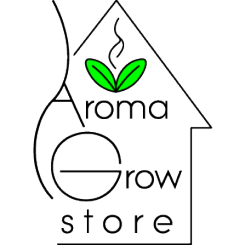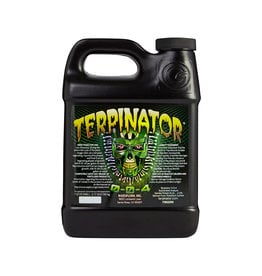Terpinator
ABOUT TERPINATOR
Terpinator is the original terpene enhancing fertilizer additive designed to improve terpene concentration in your plants.
Terpinator is the result of years of trials by a dedicated team of professional cultivators who wanted just a bit more from their harvests. More taste, more aroma, and a higher potency – no matter the plant. They knew that the key to getting the results they were looking for was in the terpenes – the building blocks of the essential oils found in most plants and flowers.

The Terpinator Crew
Tested on farms throughout Sonoma and Mendocino counties in indoor, outdoor, and hydroponic scenarios, the team wasn’t satisfied until they felt that their plants had begun increasing their cultivar-specific terpene profile as much as possible, resulting in grows that had a marked increase in the “more” they’d been working towards: smell, taste, and potency. The first successful lot of Terpinator was launched in 2014, and has been used by serious cultivators ever since.
Terpinator is produced in Sonoma County, California by a team dedicated to quality and consistency; this ensures that every batch is made with the same level of care and precision as the first.
We encourage all growers, new or experienced to try Terpinator and smell, taste, and feel the results first-hand - you’ll be glad you did!
A ONE-OF-A-KIND FOUR-STEP PROCESS

01. TRANSPORTS
After application, Terpinator travels to plant cells in direct contact with the epidermal layer of the plant.

02. STORES
Terpinator is then stored in plant cells, and pushed into storage with the help of bioosmotic potentiators until ready for use.

03. BUILDS
Terpinator enhances plants ability to produce gland sites by being readily available as a building block for secondary metabolites.

04. PRODUCES
By providing the necessary building blocks for secondary metabolites, trichome counts and productivity rapidly increases.
POTASSIUM (K) AND TERPINATOR
Potassium (K) is found in most soils in relative amounts. Many soils can contain K, but the K is insoluble as it is bound to many soil components, such as mica, humus or clay. Potassium is absorbed by plants in the cationic form, or K+. It is this reason that K is best supplied to plants from an external source in a soluble form (K+). Sulfate of Potash is one such source of absorbable K for plants uptake. For plants grown in greenhouses and hydroponically, the soluble form of K is the best source for the plant. Outdoors plants need even more K depending on the soil type, as most native soils and commercial soil products contain bound up K.
Potassium is one of the most mobile elements in the plants body, as it is found in the major tissues, organs, and inside any given cell in the plant. Potassium is necessary for the enzymatic reactions that occur in the outer most layers of the plants body (epidermis, trichomes) to function properly. Due to its high concentration in the cytosol and chloroplasts, it will cause the pH of these areas to be between 7 and 8, which is a necessary prerequisite for proper enzymatic function. This is accomplished as K neutralizes the soluble and insoluble macromolecular anions. Potassium activates enzymes by prompting conformational changes in the enzyme protein. These changes increase the rate of catalytic reactions, and also can increase the affinity of the enzyme for its substrate. For example, the enzyme starch synthase catalyzes the transfer of glucose to starch molecules. Potassium is the most effective univalent cation to increase the enzymes activity.
Potassium is involved in osmosis and ionic balance and in opening closing stomata; critical, on time activator of the most important plant enzymes. Uptake of ions by plant cells results in water being taken into the cytoplasm of the plant cell. Potassium ions change the osmotic potential in plant cells, acting as a solute while maintaining turgor pressure of the cells. Turgor is the pressure a cell exhibits when water moves into it. Plants wilting have lost their turgor pressure within the cells that comprise the plant’s body.
High osmotic potential in the central vascular cylinder of the plant’s roots is a prerequisite for turgor driven nutrient transport in the tissue that brings water to all the plant parts. Without the correct amount of K in the vascular cylinder, the plant cannot uptake water and nutrients in a manner that allows the plant to thrive in rapid grow environments.
Potassium also plays a strong roles in protein synthesis. Again, the formation and activation of critical enzymes (e.g., nitrate reductase) is limited by the presence of K in the cells of the plant. Protein syntheses is necessary for the production of soluble nitrogen compounds, such as amino acids, nitrate, etc.). In the absence of proteins, plants cannot grow and set fruits, or form roots properly.
Cell extension in a plants body cannot occur without potassium. The concentration of K in the plants cells is critical for the correct osmotic potential and pH of the cell’s cytoplasm. Potassium and sugars work together to allow plant cells to multiply at accelerated rates.
Potassium is the major solute behind how leaves can move. Leaves need to orient themselves to the position of light, whether to move to better intercept the light, or move away if the light is too intense. For example, changes in turgor pressure in and around leaf petioles due to the correct concentration of Potassium allows a leaf to orient itself in the proper direction. Since plants are sedentary and cant get up and walk around, this is the only way they can capture the correct amount of light in order to feed themselves, set fruit, and reproduce.
For plants that are grown in high intensity greenhouses, the plant will need more potassium to help manage how the plant drinks water. The pores that allow a plant to pull CO2 in and H20 and O2 out are called stomates. These cells are regulated by the density of K around them. If K levels are incorrect, the plant will lose more water, with a correlated drop in turgor pressure. The correct levels of K allows these specialized cells to open and close as necessary.
Potassium plays a critical role in carbohydrate movement, as K+ aids the loading of sucrose from source locations (e.g., leaves) and into the plant's vascular system. Osmotic forces due the presence of K+ acting with certain plant enzymes helps maintain the movement of sucrose in the plants body, and insures its distribution to plant organs.
Overall K+ is one of the most critical macro minerals for a plant to grow properly. Potassium is needed by the plant in every aspect of its life cycle, from seed germination to vegetative phases and fruit set. Unlike Nitrogen and Phosphorus, Potassium does not become part of any plant component. Since K+ is stored in the plants cellular cytoplasm and sap, it must be provided to a plant all the time. Potassium is responsible for the cellular regulation of over 60 different enzymes in meristematic tissues. In summary K+ is responsible for regulating enzyme activity, regulating CO2 and water through osmoregulation of the plant' stomata, and is essential for the production of ATP. By insuring plants have the correct forms and amount of Potassium available, proper growth from seed to fruit set is insured.


